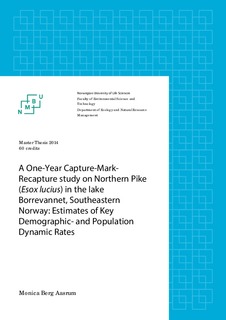| dc.contributor.author | Aasrum, Monica Berg | |
| dc.date.accessioned | 2014-09-26T07:31:45Z | |
| dc.date.available | 2014-09-26T07:31:45Z | |
| dc.date.copyright | 2014 | |
| dc.date.issued | 2014-09-26 | |
| dc.identifier.uri | http://hdl.handle.net/11250/221655 | |
| dc.description.abstract | Northern pike (Esox lucius) is distributed through Europe, Asia and North-America and is an important species in both commercial and recreational fisheries. It is a top predator that has an important role in regulation fish communities through predation and cannibalism.
Borrevannet is a shallow and eutrophic lake located in Vestfold County, SE Norway. Cyprinids (mainly roach (Rutilus rutilus) and bleach (Alburnus alburnus)) dominate the fish community and pike along with large individuals of perch (Perca fluviatilis) constitute top predators. There is a latent conflict related to the way pike is supposed to be managed in the system. Anglers want to favor a large proportion of large pike individuals in the population, whereas regional water management authorities would rather favor a large proportion of medium-sized pike as this will improve the water quality due to medium-sized pike being the more effective roach predators. In order to arrive at a sustainable and justifiable pike management policy of the lake, detailed information about the pike population is a prerequisite. How the pike would be managed in Borrevannet could be a conflict of interest for the landowners whether deciding to focus on sports fishing or to improve the water quality. It is on that basis that I have done my study on the pike population in Borrevannet.
The objective of this study was to estimate the population size, survival and migration rate of Borrevannet pike through capture-mark-recapture (CMR) analysis over 5 mark-recapture occasions covering a year. From scale samples individual back-calculated growth trajectories could be read and size-at age data was used for analysis of ambient temperature on growth. The population size of Borrevannet pike (larger than 40 cm) was estimated to be around 500 individuals. First-year individual growth in male pike responded positively to increasing ambient temperature, whereas females showed the opposite effect. Second- and third-year growths were either negatively or insignificantly affected by monthly growth-season temperatures. Cormack-Jolly-Seber (CJS) models were fitted the CMR-data used and the most supported model (AIC based) predicted that recapture probability for pike 40-65 cm was positively size-dependent during spring and negatively during fall. This finding can be related to differential activity levels between small and larger individuals during the two seasons. Borrevannet pike had an estimated monthly survival of 0.97, corresponding to an annual survival rate of 0.61. Most of the pike did not disperse far from the original marking point when recaptured (50 % dispersed less than 163 m), but there were a few individuals who dispersed up to more than 2000 m.
Borrevannet landowners association want to utilize the fishing resource for recreational- and sports fishing, but also improve the water quality in the lake. This may come in conflict with keeping a portion of large pike in the population for sports fishing. Estimated density of pike was low compared to other lakes. This may be because large pike, through cannibalism, forage on smaller individuals. Since the mark-recapture analysis did not show any size dependent survival, predation on smaller pike is uncertain. The mark-recapture study needs to continue to determine the relationship between harvest mortality and natural mortality via cannibalism. | nb_NO |
| dc.language.iso | eng | nb_NO |
| dc.publisher | Norwegian University of Life Sciences, Ås | |
| dc.subject | Northern Pike | nb_NO |
| dc.subject | Mark-recapture | nb_NO |
| dc.subject | Survival | nb_NO |
| dc.subject | Population estimates | nb_NO |
| dc.subject | Growth | nb_NO |
| dc.subject | Management | nb_NO |
| dc.subject | Migration | nb_NO |
| dc.title | A one-year capture-mark-recapture study of Northern Pike (Esox lucius) in the lake Borrevannet, southeastern Norway : estimates of key demographic- and population dynamic rates | nb_NO |
| dc.title.alternative | En ett-års merke-gjenfangst studie av gjedde (Esox lucius) i Borrevannet, i sørøst Norge: Estimater av vitale demografiske og populasjonsdynamiske rater | nb_NO |
| dc.type | Master thesis | nb_NO |
| dc.subject.nsi | VDP::Agriculture and fishery disciplines: 900::Fisheries science: 920::Resource biology: 921 | nb_NO |
| dc.source.pagenumber | 49 | nb_NO |
| dc.description.localcode | M-NF | nb_NO |
